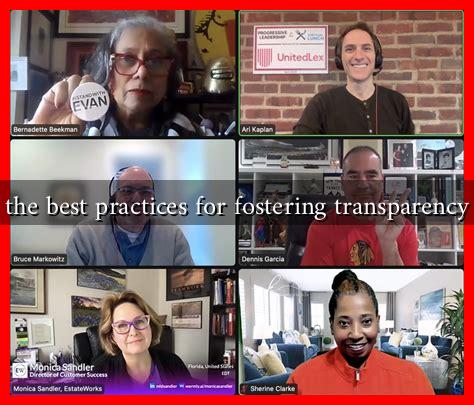-
Table of Contents
What are the Best Practices for Fostering Transparency and Trust?
In an era where information is abundant and skepticism is rampant, fostering transparency and trust has become essential for organizations, leaders, and individuals alike. Transparency not only enhances credibility but also strengthens relationships, boosts morale, and drives engagement. This article explores best practices for cultivating transparency and trust, supported by relevant examples and statistics.
Understanding Transparency and Trust
Transparency refers to the openness and clarity with which information is shared, while trust is the confidence that stakeholders have in the integrity and reliability of an individual or organization. Together, they form the foundation of effective communication and collaboration.
Best Practices for Fostering Transparency
Implementing best practices for transparency can significantly enhance trust within an organization. Here are some key strategies:
- Open Communication Channels: Establishing multiple channels for communication encourages feedback and dialogue. Regular town hall meetings, suggestion boxes, and open-door policies can facilitate this.
- Share Information Freely: Providing access to relevant data, reports, and decision-making processes helps stakeholders understand the rationale behind actions. For instance, companies like Buffer share their revenue and employee salaries publicly, promoting a culture of openness.
- Be Honest About Challenges: Acknowledging difficulties and setbacks fosters a culture of authenticity. For example, when companies like Tesla faced production delays, they communicated openly about the challenges, which helped maintain trust among investors and customers.
- Encourage Employee Involvement: Involving employees in decision-making processes can enhance transparency. Organizations like Zappos utilize holacracy, allowing employees to have a say in how the company operates.
Building Trust Through Consistency
Consistency is crucial in building trust. Here are some practices that can help:
- Deliver on Promises: Following through on commitments is vital. Research by the American Psychological Association indicates that trust is built when individuals consistently meet expectations.
- Maintain Ethical Standards: Upholding ethical practices reinforces trust. Companies like Patagonia are known for their commitment to environmental sustainability, which resonates with their customer base.
- Regularly Update Stakeholders: Keeping stakeholders informed about changes, progress, and future plans helps maintain trust. For instance, during the COVID-19 pandemic, many organizations provided regular updates to employees about safety measures and business continuity plans.
Leveraging Technology for Transparency
In today’s digital age, technology plays a pivotal role in enhancing transparency. Here are some ways to leverage technology:
- Utilize Collaboration Tools: Platforms like Slack and Microsoft Teams facilitate real-time communication and information sharing, making it easier for teams to stay aligned.
- Implement Data Analytics: Using data analytics tools can help organizations make informed decisions and share insights with stakeholders. For example, companies can use dashboards to display key performance indicators (KPIs) transparently.
- Adopt Blockchain Technology: Blockchain can enhance transparency in transactions by providing a secure and immutable record. Industries like finance and supply chain are increasingly adopting this technology to build trust.
Case Studies: Successful Implementation of Transparency and Trust
Several organizations have successfully implemented transparency and trust-building practices:
- Whole Foods Market: The grocery chain is known for its transparent sourcing practices, allowing customers to trace the origins of their food. This commitment to transparency has fostered customer loyalty and trust.
- Starbucks: The company regularly shares its sustainability goals and progress with customers, reinforcing its commitment to ethical sourcing and community engagement.
Conclusion
Fostering transparency and trust is not merely a best practice; it is a necessity in today’s interconnected world. By implementing open communication, maintaining consistency, leveraging technology, and learning from successful case studies, organizations can build a culture of trust that enhances relationships and drives success. As the saying goes, “Trust is built with consistency.” By committing to transparency, organizations can create an environment where trust flourishes, ultimately leading to greater engagement, loyalty, and success.
For further reading on the importance of transparency in organizations, you can visit Forbes.

